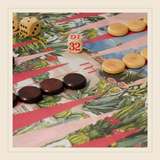A TALENTED ILLUSTRATOR
Gifted with remarkable drawing talent and expert mastery of color composition, she brings exquisite delicacy to life in her paintings. Her tribute to nature, through stunning yet authentic settings, captures the essence and magic of the surreal landscape offered by the Exotic Garden, thus transporting viewers to a fairy-tale world that is nonetheless very real.
A passionate and talented artist, she merges the traditional brushwork with the subtle skill of the graphic tablet stylus, creating a harmony between classical artistic techniques and contemporary digital tools.
Her collaboration with renowned luxury houses attests to her artistic excellence, which she has joyfully and enthusiastically deployed in the creation of the “Le Jardin Exotique de Monaco” collection for Monoïkos 1297!
A note of history
The Exotic Garden of Monaco is a true gem of the Principality, a verdant oasis suspended between sky and sea, offering a dazzling spectacle of nature in all its splendor. Situated on a hillside, this unique botanical garden is a genuine ode to biodiversity, a place where rare and fascinating plant species from all corners of the world coexist.
The Exotic Garden of Monaco was created under the initiative of Prince Albert I, a great enthusiast of nature and sciences. He began the collection of exotic plants, particularly cacti and succulents, during his travels around the world.Inaugurated in 1933 by Prince Louis II, the Exotic Garden of Monaco was designed as a sanctuary for exotic plants, especially cacti and succulents, which are cherished and preserved here in an environment that faithfully replicates their natural habitat.
Strolling through the garden’s pathways, one is immediately struck by the diversity and beauty of shapes and colors. Giant, sculptural cacti reach towards the sky, while thick, fleshy agave leaves bask in the sunlight. All of this is enhanced by an unbeatable panoramic view of the Mediterranean Sea and the Principality of Monaco.
However, the Exotic Garden of Monaco is not just a place for contemplation. It is also a center for research and conservation where scientific work is conducted to preserve these plant species, threatened by climate change and the destruction of their natural habitats.
Lastly, the Exotic Garden of Monaco is also a place of historical significance. It houses the Observatory Cave, a classified prehistoric site where remains of Neanderthal men and extinct animals have been discovered.
The Exotic Garden of Monaco is a world apart, where nature reigns supreme, and where each plant, each rock, each view of the sea tells a story. It is a magical place that amazes and inspires, bearing witness to the Principality’s commitment to preserving our precious biodiversity.
A backgammon of exception
Our travel backgammon, entirely designed and made in France by a passionate craftsman, is the fruit of excellent know-how.
Its exclusive, patented magnetic game board offers a unique playing experience. Whether you're playing outdoors or indoors, you can play with complete peace of mind without worrying about the pieces moving. A game started outdoors continues uninterrupted indoors, with perfect stability.
Its generous dimensions (68 x 36 cm) ensure optimum comfort for real games of backgammon, while showcasing the unique designs of each of our collections.
The counters, carefully crafted from boxwood in elegant shades of cream and dark brown, have built-in magnets for impeccable playing precision. A subtly integrated pocket provides elegant storage.
Covered in alcantara and finished in French leather, this game board embodies a refined, timeless style. Easy to transport, it rolls up and slips into its matching case, also handcrafted in alcantara, with a leather handle for a final touch of luxury.
The "Le Jardin Exotique" travel backgammon celebrates the geographical splendour of Monaco by taking its inspiration from an antique map, infusing each game with authentic charm.
"Le Jardin Exotique" travel backgammon celebrates the geography of the Principality of Monaco in drawings.
The Monoïkos 1297 advices
Preserve the elegance of your backgammon:
• Gently roll up the game, ensuring that the board is facing outward, starting from the pocket containing the pieces without exerting excessive pressure.
• Once carefully rolled, with the illustration facing outward, insert it into its cover with care.
If the game is not used for an extended period, remove it from its cover and lay it flat to preserve its quality.
• If one of the pieces no longer sticks to the mat, it's possible that its magnet has detached and been attracted to another magnet. Retrieve it and you can reattach it with a suitable adhesive, such as super glue.
• The game should never be machine washed. In case of accidental moisture on the game surface, ensure to dry it quickly using a hair dryer, by exposing it to sunlight, or by any other appropriate means. This precaution is essential to prevent the appearance of rust spots that could compromise its quality.
• If creases appear, you can iron your game, except for the printed part, to restore its impeccable appearance.

The rules of
Backgammon
A game of Backgammon is played between two players. The game takes place on a board with 24 triangles, also known as points, alternating between two distinct colors.
Each player has 15 checkers of their own color, which they move from point to point based on the roll of two dice.
The goal is to move all of your checkers into your home board and then bear them off the board.
The winner is the first to bear off all 15 checkers.
Movement occurs from the opponent's home board to your own home board, with no backward movement allowed for either player.
To determine who starts, each player rolls one die, and the player with the higher roll plays first, using the combined value of both dice. In case of a tie, the roll is repeated, ensuring that no game starts with a double.
Each player moves their checkers according to the numbers rolled, then picks up their dice to signal the end of their turn. Moves are made independently for each die, except in the case of a double, where four moves are made.
A checker can land on an empty point, a point occupied by the player's own checkers, or a point occupied by a single opposing checker, resulting in a hit. (In the event of a hit, the opponent's checker is placed on the bar and must re-enter the game in the opponent's home board.)
A checker cannot land on a point occupied by two or more opposing checkers. A point occupied by two or more checkers of the same player is called a block. The opponent cannot land on or pass through a blocked point but can jump over it. Note: There is no limit to the number of checkers of the same color on a single point.
The bearing-off phase, the final stage of the game, begins once all of a player's checkers are in their home board. Each die allows a checker to be borne off from the corresponding point, unless there is no checker on that point, in which case the player must make another legal move. There are two cases:
Bearing off a checker is not mandatory if it can be replaced by the legal movement of another checker. As before, doubles are played twice (four moves).
The stakes vary depending on the bearing off and the game situation:
If the losing player has not borne off any checkers but has no checkers in the opponent's home board or on the bar, the game is declared a gammon or double, and the winner scores two points (or twice the value indicated by the doubling cube).
If the losing player has not borne off any checkers and still has one or more checkers in the opponent's home board or on the bar, the game is declared a backgammon or triple, and the winner scores three points (or three times the value indicated by the doubling cube).
A checker hit and placed on the bar:
There is no limit to the number of checkers on the bar. A checker on the bar re-enters the game by landing in the opponent's home board (points 1 to 6) based on the roll of the dice: a 1 allows entry on the opponent's 1-point, a 2 on the 2-point, etc., provided the entry point is not occupied by a block. If a player has one or more checkers on the bar, they must re-enter all of them before making any other move. If the dice do not allow this, the player must pass their turn.
The doubling cube:
A six-sided cube (2, 4, 8, 16, 32, and 64) is used to increase the stakes of the game. At the start of each game, the doubling cube is placed on the bar or the side of the board, indicating that the game's stake is one point. To double the stake, a player must wait for their turn and do so before rolling the dice. They then present the cube to their opponent with the top face showing the value 2, saying "I double" or an equivalent phrase.
Its use can be accepted or declined by the opponent, affecting the course of the game.
Later in the game, the player who accepted the double becomes the owner of the cube and is the only one who can redouble to 4, following the same procedure as the initial double. If the redouble is accepted, the new owner will be the only one able to redouble to 8, and so on.
The match:
A match is played until one player reaches a predetermined odd number of points. Points are awarded at the end of each game based on the results, and the first player to reach the required number wins the match, following the Crawford rule.
This rule states that if one player is one point away from winning, the doubling cube cannot be used in that game.




